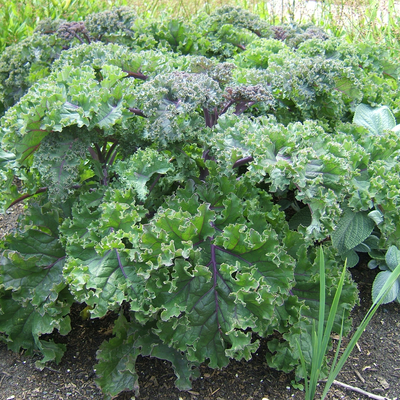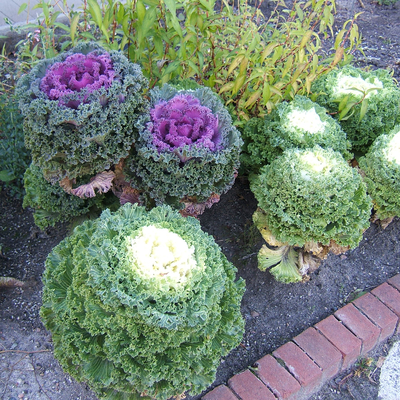Quick facts
- Grow where you have not grown cabbage, cauliflower, broccoli, Brussels sprouts, collards, kale, mustard, turnip or rutabaga for the past four years.
- Direct seed or start indoors in April.
- For fall crops, start seed indoors in June.
- If the plants are overheated or struggling to take up water, they will produce chemicals resulting in pungent or bitter flavors.
Hardy leafy greens
Collards and kale (Brassica oleracea var. acephala) are leafy forms of the same species as broccoli, cauliflower and cabbage. Collards produce large, smooth, thick leaves, while kale leaves are curly, ruffled or lobed on the edges. Russian or Siberian kale is a very similar plant of a different species (Brassica napus var. pabularia).
You can eat both collards and kale raw when the leaves are small and tender. You can cook the larger, tougher, more mature leaves, as well as stew, braise, stir-fry or even make them into kale chips.
Both plants are cold tolerant and will continue to grow and produce new leaves well beyond the first fall frosts. Even after they have frozen, you can harvest and cook the leaves straight from the garden.
Soil pH and fertility
- Have your soil tested.
- A neutral soil pH of 6.0 to 7.5 is ideal.
- Apply phosphorus (P) and potassium (K) according to soil test recommendations. Many Minnesota soils have enough phosphorus.
- Unless your soil test report specifically recommends additional phosphorus, use a low- or no-phosphorus fertilizer.
- Kale and collards do best in loamy, well-drained soil with high organic matter.
- You can achieve acceptable kale on heavier, well-drained soil.
- As long as you make sure the plants are well watered, you can do the same on sandier soils.
- Improve your soil by adding well-rotted manure or compost in spring or fall. Do not use fresh manure as it may contain harmful bacteria and may increase weed problems.
- When the plants are about four inches tall, apply fertilizer alongside the row of plants at a rate of one-half cup of 46-0-0, or one cup of 27-3-3, or 3-½ cups 10-3-1 for each 100 feet of row.
- Spread the fertilizer in a six-inch wide band, and scratch it into the surface of the soil.
- If you use manure or compost, you may not need additional fertilizer applications, depending on how much organic matter you apply.
- Do not use any fertilizer containing a weed killer ("Weed and Feed"), as it may kill your vegetable plants.
Planting
- Sow seeds in the spring for an early summer crop as soon as the soil is workable.
- Direct seed again about three months before the average frost date for a fall crop.
- Plant seeds one-fourth to one-half inch deep, in rows 18 to 30 inches apart.
- Thin seedlings after they emerge allowing eight to 12 inches between them.
- Start seeds indoors. Plant in early April, or about four weeks before transplanting.
- For fall crops, start seed in June.
- Harden seedlings by reducing water and temperature two to three days before transplanting.
- Transplant the seedlings eight inches apart, in rows 18 inches apart.
- If you plan to harvest “baby” leaves only, space the plants as close as four inches apart in the row.
How to keep your collard and kale plants healthy and productive
- The best quality of kale or collards—flavorful, tender, non-bitter leaves—results from fast growth without heat or moisture stress.
- If the plants are overheated or struggling to take up water, they will produce chemicals resulting in pungent or bitter flavors.
- One inch of rainfall per week is good.
- An inch of water will wet a sandy soil to a depth of ten inches, a heavy clay soil to six inches.
- If your soil is sandy, it is better to water more often than once a week.
- Use a trowel to see how far down the soil is wet. If it is only an inch or two, keep the water running.
- Frequent, shallow cultivation will kill weeds before they become a problem.
- Cultivate just deeply enough to cut the weeds off below the surface of the soil. Be careful not to damage the plants when cultivating.
- Mulching with herbicide-free grass clippings, weed-free straw, or other organic material to a depth of three to four inches can help prevent weed growth, decreasing the need for frequent cultivation.
For assistance in diagnosing unknown problems, visit the University of Minnesota Extension diagnostic site “What’s wrong with my plant?”
Practice crop rotation. Choose a location in your garden where you have not grown cole crops -- cabbage, cauliflower, broccoli, Brussels sprouts, collard, kale, mustard, turnip or rutabaga -- for the past four years.
- Harvest single leaves as soon as they reach a usable size.
Nagoya kale plants - If you harvest individual leaves at the "baby" stage, leaving most of the small leaves on the plant, multiple harvests are possible before the plants exhaust their resources.
- Alternatively, you can remove the whole plant by cutting it off at or just before the soil surface.
- For the spring crop, flavor is best if you harvest the plants before the weather becomes hot and dry.
- Heat will slow growth and leaves will become tough and strong flavored.
- For the fall crop, the cooler the weather, the better the flavor, until freezing temperatures stop growth.
- Because you can harvest these greens well into the cold season, it is traditional to eat them until they are gone, rather than trying to preserve them. Freezing is an option if you have a particularly abundant crop.
Managing pests, diseases, and disorders
Many things can affect cabbage leaves, roots, and heads. Changes in physical appearance and plant health can be caused by the environment, plant diseases, insects and wildlife. In order to address what you’re seeing, it is important to make a correct diagnosis.
You can find additional help identifying common pest problems by using the online diagnostic tools or by sending a sample to the UMN Plant Disease Diagnostic Clinic. You can use Ask a Master Gardener to share pictures and get input.
Managing pests, diseases, and disorders
Many things can affect cabbage leaves, roots, and heads. Changes in physical appearance and plant health can be caused by the environment, plant diseases, insects and wildlife. In order to address what you’re seeing, it is important to make a correct diagnosis.
You can find additional help identifying common pest problems by using the online diagnostic tools or by sending a sample to the UMN Plant Disease Diagnostic Clinic. You can use Ask a Master Gardener to share pictures and get input.
Minnesota is home to many insects that feed on collards and kale. Some level of insect damage is just part of growing these plants in Minnesota.
- Flea beetles chew small holes in leaves. Seedlings are most vulnerable to injury from this feeding.
- Imported cabbage worm, cabbage looper, and diamondback moth larvae feed on the leaves. Young seedlings and transplants are most vulnerable to injury from this feeding.
- Cabbage maggots feed on the roots, injuring the plants, sometimes killing them.
- Swede midge is a new pest in Minnesota that can cause distorting and stunting. They particularly love red Russian kale varieties.
Many of the same cultural practices can help prevent a wide variety of kale and collard diseases. .
- Alternaria is a common disease that causes spots on leaves.
- Black rot causes yellow triangles on the edge of leaves.
Clubroot attacks the roots of kale and collards, causing roots to be swollen and plants to be stunted.
Reviewed in 2022



